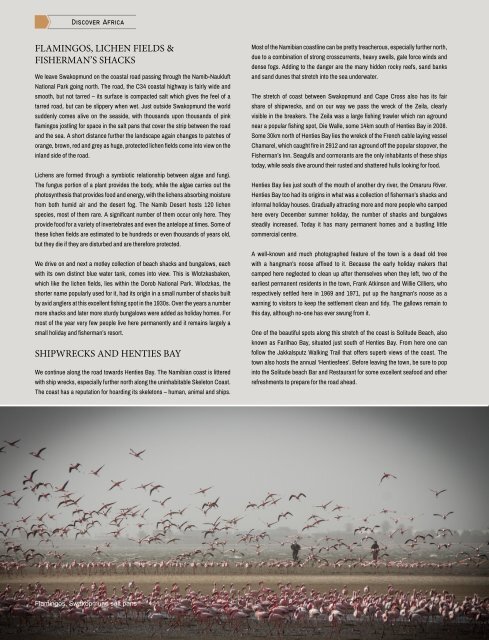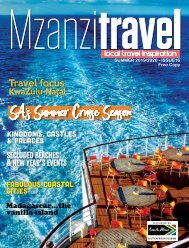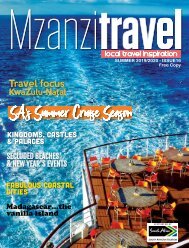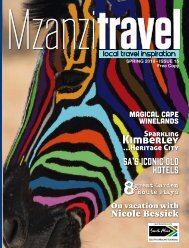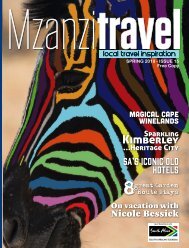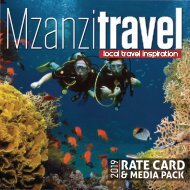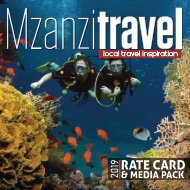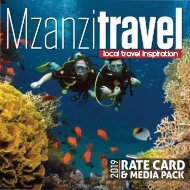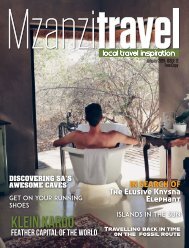Mzanzitravel Magazine - Issue 9
MzanziTravel Magazine is a local travel inspiration for tourists (local and international) to discover the best places to visit in Africa.
MzanziTravel Magazine is a local travel inspiration for tourists (local and international) to discover the best places to visit in Africa.
You also want an ePaper? Increase the reach of your titles
YUMPU automatically turns print PDFs into web optimized ePapers that Google loves.
Discover Africa<br />
FLAMINGOS, LICHEN FIELDS &<br />
FISHERMAN’S SHACKS<br />
We leave Swakopmund on the coastal road passing through the Namib-Naukluft<br />
National Park going north. The road, the C34 coastal highway is fairly wide and<br />
smooth, but not tarred – its surface is compacted salt which gives the feel of a<br />
tarred road, but can be slippery when wet. Just outside Swakopmund the world<br />
suddenly comes alive on the seaside, with thousands upon thousands of pink<br />
flamingos jostling for space in the salt pans that cover the strip between the road<br />
and the sea. A short distance further the landscape again changes to patches of<br />
orange, brown, red and grey as huge, protected lichen fields come into view on the<br />
inland side of the road.<br />
Lichens are formed through a symbiotic relationship between algae and fungi.<br />
The fungus portion of a plant provides the body, while the algae carries out the<br />
photosynthesis that provides food and energy, with the lichens absorbing moisture<br />
from both humid air and the desert fog. The Namib Desert hosts 120 lichen<br />
species, most of them rare. A significant number of them occur only here. They<br />
provide food for a variety of invertebrates and even the antelope at times. Some of<br />
these lichen fields are estimated to be hundreds or even thousands of years old,<br />
but they die if they are disturbed and are therefore protected.<br />
We drive on and next a motley collection of beach shacks and bungalows, each<br />
with its own distinct blue water tank, comes into view. This is Wlotzkasbaken,<br />
which like the lichen fields, lies within the Dorob National Park. Wlodzkas, the<br />
shorter name popularly used for it, had its origin in a small number of shacks built<br />
by avid anglers at this excellent fishing spot in the 1930s. Over the years a number<br />
more shacks and later more sturdy bungalows were added as holiday homes. For<br />
most of the year very few people live here permanently and it remains largely a<br />
small holiday and fisherman’s resort.<br />
SHIPWRECKS AND HENTIES BAY<br />
We continue along the road towards Henties Bay. The Namibian coast is littered<br />
with ship wrecks, especially further north along the uninhabitable Skeleton Coast.<br />
The coast has a reputation for hoarding its skeletons – human, animal and ships.<br />
Most of the Namibian coastline can be pretty treacherous, especially further north,<br />
due to a combination of strong crosscurrents, heavy swells, gale force winds and<br />
dense fogs. Adding to the danger are the many hidden rocky reefs, sand banks<br />
and sand dunes that stretch into the sea underwater.<br />
The stretch of coast between Swakopmund and Cape Cross also has its fair<br />
share of shipwrecks, and on our way we pass the wreck of the Zeila, clearly<br />
visible in the breakers. The Zeila was a large fishing trawler which ran aground<br />
near a popular fishing spot, Die Walle, some 14km south of Henties Bay in 2008.<br />
Some 30km north of Henties Bay lies the wrekck of the French cable laying vessel<br />
Chamarel, which caught fire in 2912 and ran aground off the popular stopover, the<br />
Fisherman’s Inn. Seagulls and cormorants are the only inhabitants of these ships<br />
today, while seals dive around their rusted and shattered hulls looking for food.<br />
Henties Bay lies just south of the mouth of another dry river, the Omaruru River.<br />
Henties Bay too had its origins in what was a collection of fisherman’s shacks and<br />
informal holiday houses. Gradually attracting more and more people who camped<br />
here every December summer holiday, the number of shacks and bungalows<br />
steadily increased. Today it has many permanent homes and a bustling little<br />
commercial centre.<br />
A well-known and much photographed feature of the town is a dead old tree<br />
with a hangman’s noose affixed to it. Because the early holiday makers that<br />
camped here neglected to clean up after themselves when they left, two of the<br />
earliest permanent residents in the town, Frank Atkinson and Willie Cilliers, who<br />
respectively settled here in 1969 and 1971, put up the hangman’s noose as a<br />
warning to visitors to keep the settlement clean and tidy. The gallows remain to<br />
this day, although no-one has ever swung from it.<br />
One of the beautiful spots along this stretch of the coast is Solitude Beach, also<br />
known as Farilhao Bay, situated just south of Henties Bay. From here one can<br />
follow the Jakkalsputz Walking Trail that offers superb views of the coast. The<br />
town also hosts the annual ‘Hentiesfees’. Before leaving the town, be sure to pop<br />
into the Solitude beach Bar and Restaurant for some excellent seafood and other<br />
refreshments to prepare for the road ahead.<br />
Flamingos, Swakopmund salt pans


